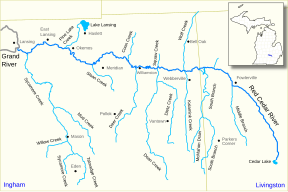Red Cedar River (Michigan)
| Red Cedar River | |
|
The Red Cedar River on the campus of Michigan State University in autumn
|
|
| Country | United States |
|---|---|
| State | Michigan |
| Counties | Ingham, Livingston |
| Cities | Fowlerville, Williamston, Okemos, East Lansing, Lansing |
| Source | Cedar Lake |
| - location | Livingston County, Michigan, United States |
| - coordinates | 42°31′03″N 83°58′42″W / 42.51750°N 83.97833°W |
| Mouth | Grand River |
| - location | Lansing, Michigan, United States |
| - coordinates | 42°43′29″N 84°32′53″W / 42.72472°N 84.54806°WCoordinates: 42°43′29″N 84°32′53″W / 42.72472°N 84.54806°W |
| Length | 51 mi (82 km) |
| Basin | 472 sq mi (1,222 km2) |
The Red Cedar River is a westward-flowing tributary of the Grand River in Michigan. Its source is Cedar Lake which is located in Marion Township in the southeastern corner of Livingston County, and it runs about 51.1 miles (82.2 km) through Okemos, East Lansing, including the campus of Michigan State University, and finally Lansing, where it empties into the Grand River. It has a West and a Middle branch, each of which also originates in southern Livingston County.
It is not navigable by boats any larger than recreational size, and is not an important shipping route. Its watershed area is estimated at 472 square miles (1,220 km2), and it has 12 tributaries of its own. Since the national Clean Water Act in 1972, the river has greatly improved and is safe for swimming 74% of the year (the exception usually being right after heavy rains which bring higher levels of E. coli from runoff waters). The Red Cedar is regularly monitored by MSU Water with the contaminant reports posted by the Michigan State University International Center. Despite these improvements, littering and pollution into the river and onto its banks is a common problem and includes bikes, parking barricades, general trash, and occasionally large items such as car tires and mopeds. To combat this problem, twice per year the undergraduate MSU Fisheries and Wildlife club holds a "Red Cedar Clean-Up" event that brings students, faculty, alumni, and community members together to remove and recycle items found in the river and its banks. The river is named for the trees commonly known as "red cedar" that were prevalent and still are somewhat common near the river's source and beginning length. The tree however, is properly a type of juniper, Juniperus virginiana.
...
Wikipedia


